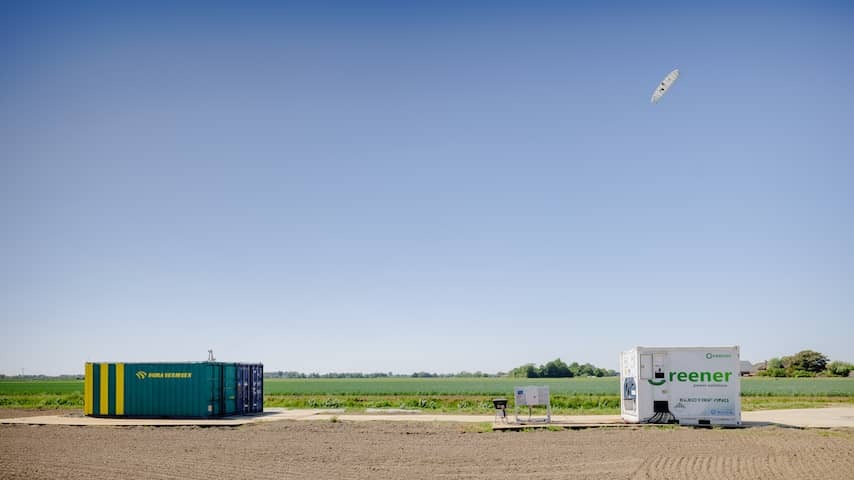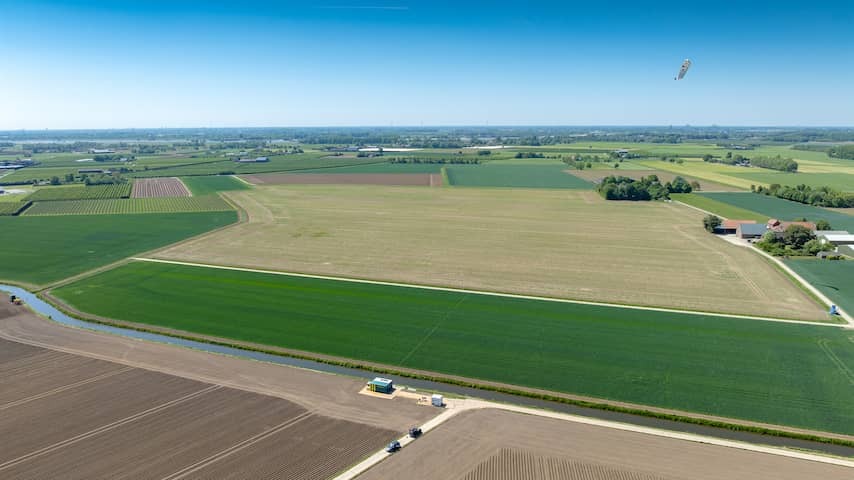
In the Koplopers series, NU.nl visits projects this summer that give us a glimpse into the sustainable future. This week: the kite that supplies wind energy to electric construction machinery.
From a distance the white object looks mysterious, here between the fields with sugar beets and wheat. Only when you get closer do you see that there is a gigantic kite on the agricultural land between Geldermalsen and De Waal, which is connected to a sea container with a long cable.
If it is up to the Kitepower company, we see a new puzzle piece here in the energy transition. This kite – an enlarged kite such as surfers who use – can generate wind energy without having to put down a gigantic windmill.
The yield is more limited: more than a hundred of these kites are needed to generate as much power as one of the large windmills that we see further down at the Deil junction.
But you can easily move the kite system and is therefore ideal as a temporary energy supply, for example at a construction site with electrical machines, Kitepower thinks.
Kites will soon fly synchronously
After a bell with the head office in Delft, the kite flies up straight up into the air. At high altitudes it starts to make a bend with the help of a small motor. By catching the wind, the kite pulls out its rope further and further, up to a length of up to 350 meters.
In the container, this rolling cable provides a rotating generator, which supplies energy to a large battery. If the cable is completely rolled, the kite will hang straight above the container. Then it catches less wind, so that the cable can be withdrawn with relatively little energy use. Then the kite sends himself into the wind again, so that he will generate energy again. Then the process starts again. With good wind, this system can deliver as much electricity as approximately 75 solar panels in full sun.
Because this is a test setup, two Kitepower employees are present to keep an eye on whether the system works well. The company is still working on a more powerful model that can generate completely autonomous energy, says director Pieter Willems. Smart control must therefore ensure that several kites can fly synchronously next to each other without crossing each other’s path.
To set up quickly
According to him, the system can primarily offer a solution at locations where there is little space, or where only temporarily sustainable energy is needed. “We can place kites in places where you just can’t put wind turbines,” says Willems.
Here at Geldermalsen, De Vlieger supplies electricity to an electric truck that is used for a large dyke improvement project. When that project is completed, the kite installation can be loaded on a truck and put somewhere else.
That is also the reason that Bouwbedrijf Dura Vermeer wanted to test the technology, says innovation manager Evan van der Holst. “It can be set up very quickly,” he says. With a large construction project you could also put the pilots in several places. “Then the equipment can charge as close as possible.”
Dura Vermeer notices that due to the overload of the power grid in more and more places it is impossible to get a connection. According to Van der Holst there is “quite a list” with projects where this problem plays.
Not yet a stable energy source
Yet for the time being, energy airgers will not go up through the whole of the Netherlands. First the technology must be further developed. Now the system is still very expensive, and moreover it is not yet stable enough as an energy source, says Van der Holst. If the wind is not (hard) for a while, the truck is without electricity. “We notice that something still needs to be done there.”
A larger battery may offer a solution to store a larger buffer of kite energy. In the meantime, Kitepower wants to collaborate with companies from, among other things, the car industry to reduce costs. “We are redesigning the system in such a way that it is completely based on standard parts available from the market.”
Willems hopes that the kites will soon be available at construction sites, but also with new residential areas that cannot get a (full) connection to the power grid. It is still a while to wait: Kitepower hopes that his advanced model will be commercially available in 2027.
In The Series Frontrunners , NU.nl Visits Projects This Summer That Give US A Glimpse Into The Sustainable Future. This week: The Kite That Supplies Wind Energy to Electric Construction Machines.
From a distance, The White Object Looks Mysterious, here Between the Fields of Sugar Beets and Wheat. Only when you get closer do you see on the agricultural land between Geldermalsen and the Waal there is a gigantic kite, which is connected to a sea container with a long cable.
If it is up to the company kitepower, we will see a new piece of the puzzle in the energy transition here. This Kite – an Enlarged Kite Like the Ones Surfers Use – Can Generate Wind Energy Without Having to Place a Gigantic Wind Turbine.
The Yield is more limited: More than a hundred of these kites are needed to generate as much power as one of the large wind turbines that we see furthe on at the deil junction.
But the Kite System is Easy to Move and is Therefore iDeal as a Temporary Energy Supply, For Example at A Construction Site with Electric Machines, Kitepower Thinks.
Kites Will Soon Fly synchronously
After a call to the head office in Delft, The Kite Flies Straight Up Into The Air. At High Altitude, IT Starts Making Bends with the Help of a Small Motor. By catching the wind, the kite pulls its rope further and further, up to a maximum length or 350 meters.
In The Container, This Unrolling Cable Provides a Rotating Generator, which Supplies Energy to a Large Battery. When the cable is fully unrolled, the kite hangs direct -above the container. Then it catches less wind, so the cable can be retracted with relatively little energy consumption. The Kite then Sends itself Back Into The Wind, Causing It to Generate Energy Again. Then the process start again. In good wind, this system can supply as much electricity as approxroximately 75 solar panels in full sun.
Because this is a test setup, Two Kitepower Employees Are Present to Monitor Whether the System is Working Properly. The Company is Still Working on a more Powerful Model That Can Generate Energyully Fully Autonomous, Says Director Pieter Willems. Smart Control Must also Ensure That Several Kites Can Fly Synchronously Next to Each Other, Without Crossing Each Other’s Path.

Quick to set up
Accordance to him, The System Can Mainly Survey A Solution in Locations Where There Is Little Space, Or Where Sustainable Energy is Only Needed Temporarily. “We can place kites in places where you simply can’t place wind turbines,” Says Willems.
Here at Geldermalsen, The Kite Supplies Power to An Electric Truck That Is Being Used In A Large Dike Reinforcement Project. Once That Project is completed, The Kite Installation Can Be Loaded Onto A Truck and Placed Somewhere Else.
That is also the reason that construction company Dura Vermeer Wanted to Test the Technology, Says Innovation Manager Evan van der Holst. “It is very quick to set up,” he says. With a Large Construction Project You Could also Place the Kites in Several Places. “Then the Equipment Can Charge As Close As Possible.”
Dura Vermeer Notices that it is Becoming Impossible to Get a Connection in More and More Places Due to the Overload of the Electricity Grid. Accordance to van der Holst, there is “quely a list” or projects where this problem is occurring.
Not yet a stable energy source
However, energy kites will not be flying across the Netherlands for the time being. First, The Technology Needs to Be Further Developed. Now the System is Still Very Exensive, And Moreover, As An Energy Source It is not Yet Stable Enough, Says van der Holst. If it Doesn’tn’t (Hardly) blow for a while, the truck will be without power. “We Notice That Something Still Needs To Be Done About That.”
A larger battery may sacrifice a solution, in order to store a larger buffer or kite energy. In The Meantime, Kitepower Wants To Work with Companies From the Automotive Industry, Among Others, to Reduce Costs. “We are redesigning the system so that it is entirely based on Standard components available on the market.”
Willems hopes that the kites will not only be found on construction sites, but also in new residential areas that cannot get a (full) connection to the electricity grid. We will have to wait a while for that: kitepower hopes that its advanced model will be commercially available in 2027.